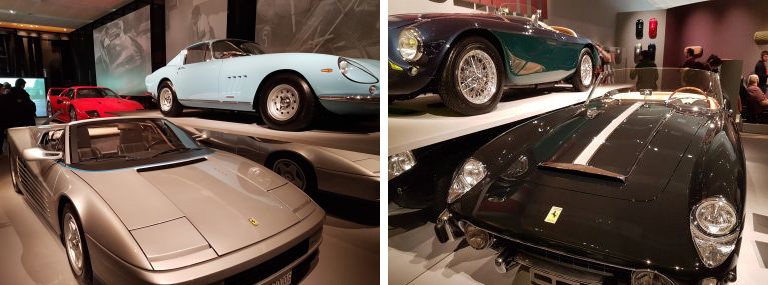The design museum London is the leading museum in United Kingdom and Europe and was founded in 1989. It was relocated to a modern Landmark in 2016 in Kensington and welcomed 2.1 million visitors since its re-opening. The design museum of London had recently launched an exhibition under the title “Under the skin” in collaboration with the most expensive and iconic car producer i.e. Ferrari.
The basic objective of “Ferrari: Under the Skin” was to offer a unique insight into the scrupulous and conscientious world of Ferrari. It was an attempt to showcase the highly polished surface of a very streamlined show about a very streamlined product. Basically it was a guy’s exhibition about very expensive boy toys because according to a survey conducted in 2013 92% of Ferraris are owned by men. Cars on exhibit were about £140 million. Most of them were exhibited by the collectors belonging to United Kingdom. The

display was consisting of 6 sections where different aspects of Ferrari were showcased. It included from sketching, then modeling to the finished products. It had also covered its racing heritage and its well-known clientele.
The first section included the beginning of Enzo Farrari’s cars which were once the racing icons. The first model of this series was 125S.
Ferrari started his career with racing in 1919. From 1919 to 1945 he was associated to different organizations . In 1945 he designed his first car “125S” and equipped this model with V12 engine because it was considered very versatile as far as sports prototypes are concerned. In 1947 this model was ready for a test drive.
The second section was consisting of initial work on the models which involves human factor. It included drawings and modeling. Initially models were created through wood and

clay. In extreme right side photograph a prototype of Ferrari is shown split into two halves. Its half side is made up of clay and the other half side is giving the finished form of the product. Extreme left photograph is showing the complete full size wooden skeleton of the product. Besides this other smaller models were also displayed. The middle photograph is giving the view of initial drawings of the model. These might be less significant but these are drawn very precisely.
The third section I would like to call joints section because it included the entire range of auto parts which are involved in locomotion. It gives the idea of engine parts and how the

parts are integrated and assembled inside the metallic casing to convert it into a world’s most wanted and efficient body of cars.
Fourth section was reserved for company’s clientele. Here were the collection of vintage cars. On the walls there were projections of Claude Lelouch’s controversial short film “Rendevous C’était un Rendez vous” (1976). It was played in a loop to mesmerize exhibit attendees. The reason behind the high demand and price of Ferrari cars is that these were

customized and limited range of cars. The world’s most expensive car sold at public auction is a Ferrari a 1962 Ferrari 250 GTO Berlinetta. only 29 pieces of this car were ever built originally. It was sold for $38m in 2014. It is another fact that of the top 10 most expensive cars six were Ferrari that were sold at the auction.
Next section was occupied with the racing history of Ferrari. Cars on display in this section were about the history of Formula 1 racing, including the first Ferrari to win the British

Grand Prix and one of Schumacher’s cars. Other than the cars there is collection of driving helmets and costumes associated with many victories over the period of a century.
The last section was about the future vision of Ferrari. A video was projected which was predicting about the possible future of Ferrari in an age of driver-less technology and electric vehicles. It was also anticipating about its importance for Formula One Car. The managing director or Formula One car told that he has a strong belief that Ferrari is an essential part of Formula 1 and it must always be preserved.
The next part of discourse was about the truck art which was lately recognized as an art form. In Pakistan truck art has origins to the colonial period dating back to 1920’s. During this period Bedford trucks were imported from England to the subcontinent. These were simply decorated with Large wooden prows at the top, decorative bumpers and decorative cabin. Cabin were mostly decorated with wooden paneling. In 1940’s logos were incorporated when the journeys turned to days and weeks. These logos started turning into highly splendid decorative motifs and a competition started.
According to the Durriya Kazi (Head of the department of visual studies at the university of Karachi),
”And the more flamboyant the design, the better business became.”
The significant change in designing appeared when a local artist “Hajji Hussain” settled in Karachi. He was an artist in fresco painting. He started to paint the trucks and introduced floral patterns in it.
According to a famous Pakistani truck artist “Haider Ali”,
“When people look to hire a truck, they feel that if it looks fancy and newly painted, Then it’s probably in better condition and they trust it more.”

Kazi also looks into more than a business expense and marketing tactics. According to her it is like a ritual that harkens back to the Sufi tradition of painting shrines to curry religious favors. Sometimes truckers spend more than their capacity on the trucks. In a survey a trucker told that he has spend his entire livelihood on his truck. So it he doesn’t decorate it with proper painting it would be like being ungrateful.

